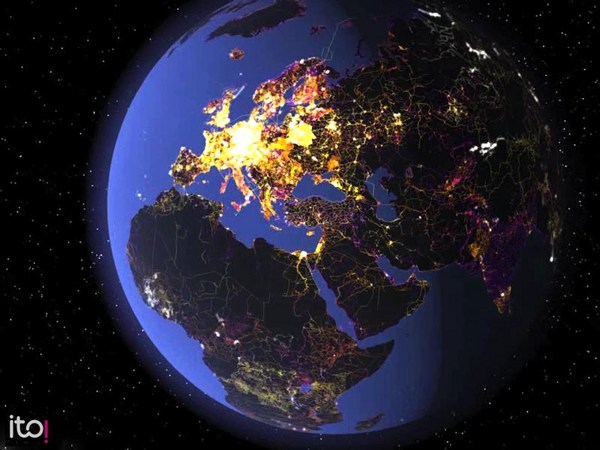Recently, I spent several days exploring Kashgar, a city in Xinjiang, northwest China. I got to wander the streets of the old town and visit the bazaar and several mosques and take in the sights. I've never been to Kashgar personally, but through the YouTube videos and Instagram posts of tourists, I was able to experience the city at a key moment in time: October 2017, just as the mass detention campaign in the region was gathering pace. These videos could help us investigate the visual signs of the crackdown. The checkpoints at each intersection with their metal detectors, ID checks and iris scans, the CCTV cameras which pervade the city and the riot police on every corner.
Over the past decade, online and open-source investigations have taken off in the fields of journalism and human rights monitoring, using photographs, videos and the digital traces we leave behind as we use the internet to conduct investigations. Social media data is combined with tools like satellite imagery and 3D modelling, as well as more traditional journalistic techniques like interviews and searches of government documents. It's also brought new kinds of people to journalism. Software developers, animators, archaeologists, or, like me, an architect.
I got involved in investigating Xinjiang in the summer of 2018 when I met Megha Rajagopalan, an American journalist who had been working in China for several years. Over the past few years, China has been carrying out a campaign of oppression in Xinjiang against Turkic Muslims, including the largest group, the Uyghurs. It's part of a campaign of forcible assimilation, and several nations have described it as a genocide. It's estimated that over a million people have been disappeared into detention camps. And while the Chinese government claims that these are part of a benign program of re-education, dozens of former detainees describe being tortured and abused and women being forcibly sterilized.
And yet, for a long time, we lacked information about what was happening in Xinjiang, because the Chinese government controls the internet tightly and restricts journalists' work in the region. Journalists would be followed or detained, and the authorities occasionally even went so far as to set up fake roadworks or stage car crashes to prevent access to certain roads. Local people who did speak to journalists face the risk of being sent to a detention camp for doing so.
Megha had been the first journalist to visit one of the camps. But shortly after publishing her article, the Chinese authorities declined to renew her visa, and she had to leave. Other journalists had managed to visit a handful of the camps, but this still represented a fraction of what we believed was out there, and no one knew where the others were. But Megha was keen to find the rest. She just needed to find a way to work effectively from outside China.
Another challenge was that Xinjiang is huge. It's four times the size of California, and that made it difficult to look for a network of camps that was spread across the region. Satellite imagery could help to solve both of those problems. But more importantly, satellite imagery was a source of information that the Chinese government couldn't control because the satellites and the imagery they produce was owned by US and European organizations. But that still left us with the question of where in that huge amount of satellite imagery to look.
And then I heard about something strange that was happening in Baidu Total View, which is the Chinese equivalent of Google Street View. Photographer Jonathan Browning had discovered that buildings and facilities like industrial estates were being photoshopped out of ground level imagery, often very clumsily. Yeah, it's bizarre, right? At the time, it wasn't clear why this was happening, but I realized that if industrial estates in eastern China were being obscured, then probably the same thing was happening with detention camps in Xinjiang. And I went to look at the imagery there to see what I could find. There were a handful of camps which had been visited by journalists. And so I went to those locations in Baidu to see what the platform showed. There was no street level imagery. But as I zoomed in on the satellite images, this weird thing happened. A light gray square suddenly appeared above the location of the camp and then disappeared just as quickly as I zoomed in further. It was a bit like the map wasn't loading properly, but then I zoomed out and in again only for the same thing to happen. I realized it couldn't be a problem with the map loading because the tiles would have been in the browser's cache. And when I found the same thing happening at the other locations we knew to be camps, I realized that we had a technique we could use to find the rest of the network.
It's quite rare for maps and satellite images to have these blank spots because blank areas tend to draw attention to themselves. But here we got lucky. Obscuring the camps had inadvertently revealed all of their locations.
(Laughter)
(Applause)
We worked with developer Christo Buschek, who specializes in documenting human rights issues and building tools for open-source researchers to map the masked-tile locations. We had to work quickly and secretively to map the masked tiles before anyone found out what we were doing and removed them because our investigation relied on access to that information. The idea was that we could go and look at the masked-tile locations and then look at that same location in other unaltered satellite imagery and see what was there. And this is what we saw. This is a former high school that became Kashgar Vocational Skills Education and Training Center. Zooming in on the satellite imagery, we can see the barbed wire in the courtyards that creates exercise pens for the detainees adjacent to the buildings. In other images, we can even see people, all wearing red uniforms, lined up in the courtyard. These features could help us decide whether a location was a camp or not.
As we investigated further, we realized that the camp's program had evolved away from the early days of makeshift camps in former schools and hospitals, and had become more permanent, that the camps were now larger, higher-security and purpose-built. This is the largest camp that we know of. It's in Dabancheng. The complex is two miles long, and it would cover a quarter of New York's Central Park. In the satellite images, we can see the thick perimeter walls, the guard towers and these blueish buildings, which we believe to be factories. We estimate that this complex can hold over 40,000 people without overcrowding. We corroborated these locations using government documents, many of which mention the camps address, the few media reports which did exist on the camps and our own interviews with former detainees who had managed to leave Xinjiang and are now living in Kazakhstan, Turkey or Europe.
In total, we found 348 locations bearing the hallmarks of camps and prisons. And we believe that this is close to being the full network. We estimate that these facilities have been built to hold more than a million people. That's enough space to detain one in every 25 of Xinjiang's residents. And that doesn't take into account the overcrowding that so many former detainees have described. So that number could be even higher.
And then one morning, a few months after we had published our map, I woke up to a series of messages about a YouTube video that was doing the rounds on Chinese social media. A Chinese vlogger, who goes by the name Guanguan, had taken our map and traveled to Xinjiang. In his video, we see him driving down a main road past a compound with barbed wire on top of the perimeter wall and bars on the windows. Next, he pretends to take a wrong turn down a side street so that he can film the facility at the end. The sign on the gate says "13th Division Detention Center." And then he hurriedly turns his car and drives away. Later, he hangs his camera from his backpack as he walks past this huge prison complex in Ürümqi. From Ürümqi he drove to the Dabancheng, that small town with the enormous detention facility that I showed earlier. He turned off the main road and drove up a gravel track, then got out of his car and climbed up on an earth berm overlooking the new compound. This was a recklessly brave thing to do because, as he notes in the video, tourists don't go to that place. He had no plausible deniability for being there. But this is the view from the top, and it's the first image that I'm aware of of the new camp at Dabancheng.
This video showed us places from ground level that previously we had only seen from above, indicating that our interpretations were correct. Seeing the signs at the gates of the facility, which told us the name and the type of facility, added further evidence that these places were camps. This video helped us to corroborate a series of locations where previously all we had had was satellite imagery.
In Xinjiang, open sources have allowed us to examine and counter the Chinese government's claims about what's happening in the region. But this isn't the only time that open-source data has led to a government losing control of their narrative. At the time, the civil war in Syria was probably the most documented conflict ever, as people filmed bombings and their aftermath and uploaded the videos to social media. Researchers like Bellingcat then used that material to investigate allegations of war crimes, such as the use of chlorine gas against civilians. Open-source data has allowed journalistic work that previously would have been really difficult, either because it happened in a place that you can’t safely go to or because often there previously wouldn't have been adequate evidence to examine.
Now researchers are using these same tools and techniques to monitor the most recent Russian invasion of Ukraine. One of the first signs of the invasion came in Google Maps with a traffic jam created by Russian artillery moving across the border that blocked the roads for civilian traffic. TikTok videos have given away Russian troop movements. Researchers are investigating potential war crimes and aiming to fact-check claims about the war in close to real time.
To do this work, satellite imagery is essential. In Xinjiang, we were lucky enough to have satellite imagery, high-resolution, up-to-date, often taken every month or so and available to us for free. This allowed us to verify potential camp locations and to follow the progress of the camp's construction closely. But this isn't true of everywhere that journalists would want to investigate, and we need affordable access to imagery of those places as well. We also rely on access to other forms of data. We not only need people to take photos and videos, we need them to upload them to a platform where researchers can access them. And then we need that material to be preserved. Often social media platforms have removed material showing violence, even when it's providing key evidence of human rights violations. Civil society actors such as the Syrian Archive have stepped in to download and preserve that material.
With social media data and satellite imagery, we can provide evidence of human rights abuses in a way that wasn't possible before. We can move beyond looking at individual instances of human rights violations to show the scale of what's happened. We can corroborate the testimony of eyewitnesses and provide further proof of their stories. We can build a more detailed picture of what's happening to inform policymakers or to provide evidence that can be presented in court. With open-source data, we can provide the evidence needed for accountability and then, hopefully, action.
Thank you.
(Applause)





